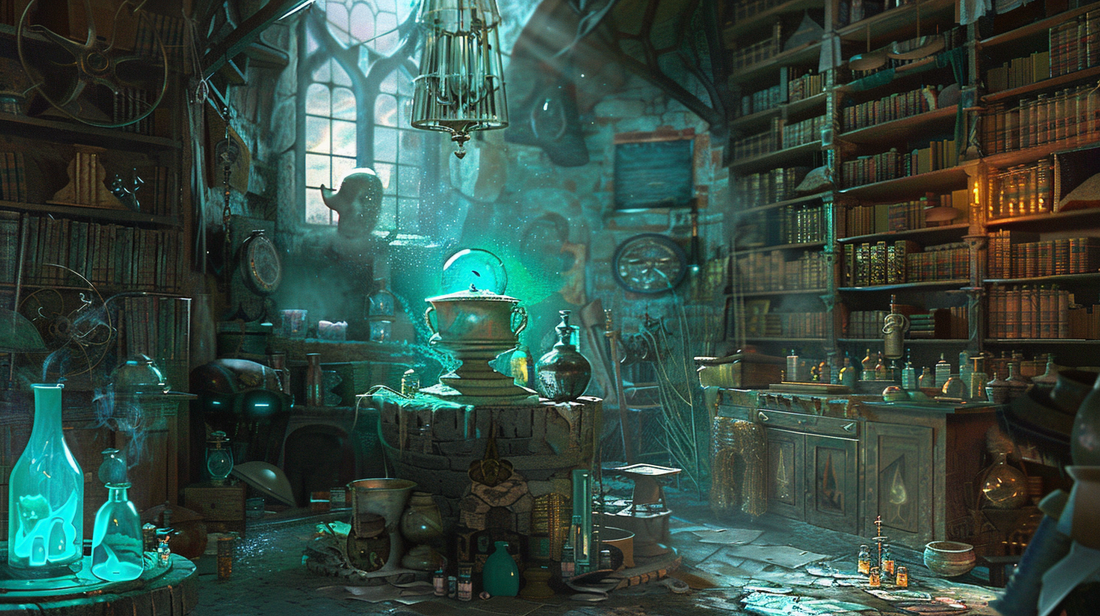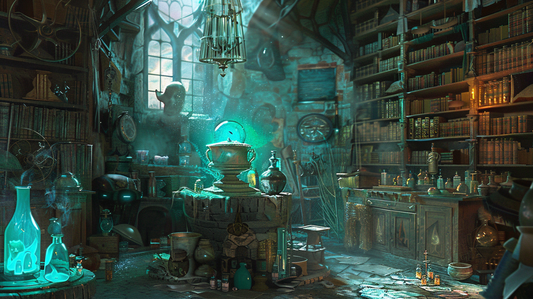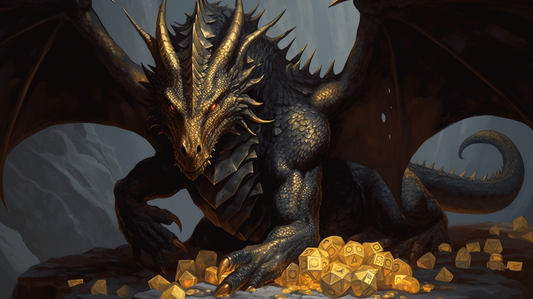
How to Make DnD Magic Items in 3 Easy Steps
Andrew ToddShare
Ready to enhance your Dungeons and Dragons (DnD) experience for your players? As a Dungeon Master, you might occasionally feel at a loss for how to inspire your adventurers with greater creativity and exciting gameplay. That’s where magic items come in!
Dnd magic items are essentially any ordinary or unordinary in-game object that has some degree of extraordinary effect. They can motivate players to set off on a quest, boost or hinder their character’s standard abilities, create memorable roleplaying moments, and more. The effects and ideas around magic items are endless which is why they are so attractive to players and Dungeon Masters (DMs) alike. In this article, we’re going to walk you through the process of crafting your own magic items in three easy steps, but first there are a few basics you should probably know.
MAGIC ITEM BASICS
Every magic item has a few common elements that help with the creation process and how it’s interpreted by your players: a name, description, category, rarity, and whether or not it requires attunement to activate. Let’s break each of those down in a little more detail.
Name
A name is obviously whatever you would like to call the magic item. There aren’t really any limitations here besides coming up with a cool name that will pique your players’ interest. Names like “Isabella’s Cloak of Cover,” “The Immortal Book of Names,” or “Earrings of the Crescent Moon” have a nice ring to them and sound like they belong in a fantasy universe. So have fun and embellish a little until you land on a name you would want to discover in an ancient, fantasy world!
Description
A magic item description is used to both explain what the physical appearance of the object is as well as provide details about its magical properties. It can vary from one or two sentences to a few paragraphs of text. We recommend being as concise as possible. What are the physical attributes about the item that stand out most, and what will happen when the magic item is used? When describing the magical properties, you’ll want to be sure to include any game mechanic language like, “If the wearer of the cloak is without cover, they gain the benefits of half cover, or +2 to their AC.” We’ll show a few more examples of this later on.
Category
According to the Dungeon Master Guide (p.139), DnD 5e magic items typically fall within one of the following nine categories:
- Armor
- Potions
- Rings
- Rods
- Scrolls
- Staffs
- Wands
- Weapons
- Wondrous Items
The last of these classifications, Wondrous Items, is basically a catch-all category for all the random objects you deem magical within your own world–things like jewelry, bags, books, vases, cloaks, etc.
Rarity
The rarity of the magic item defines how readily available or how hard it is to find, but it also helps DMs understand approximately how much it’s worth if sold and at what character level they should introduce it. The rarity scale starts with Common items of minor magical significance that most people could find in almost every town they visited, all the way to Legendary and Artifact items that are one of a kind and very powerful. Use the table below as a guide:

The rarity of some items can also be labeled as “Varies” if there are different degrees of power that this object possesses, or “Unknown” if it’s something that has never been discovered before. These are less commonly used among DMs but that doesn’t mean you should forget about them. They could lead to some unique opportunities or ideas!
Attunement
When a magic item is labeled as “requires attunement”, it means that in order to activate the full potential of the item, one must first understand and even connect with the object on a deeper level. This acts as a layer of constraint in game, because a player can only attune to a maximum of three magic items at once. To appropriately attune to an item, a character must spend an hour (or one short rest) studying or practicing with the item.
Now that we know the basics of DnD magic items, let’s get to the good part–learning how to make your own!
HOW TO MAKE DND MAGIC ITEMS

There are many methods for creating DnD magic items and they probably all result in a similar outcome. However, there are two easy methods we have found to work for us at Rune Foundry: the modification method and the homebrew method (i.e. creating an item from scratch).
The modification method. This method involves taking an existing magic item and changing one or more aspects of it. That might mean the object itself, its effect(s), or how it functions. This is a great place to start if you’re a beginner or if you’re crunched for time.
The homebrew method. Homebrewing magic items requires a little more time and thought since you’re starting from scratch, but it can also be much more rewarding when you observe your players’ excitement about a magic item you created! And even if you don’t consider yourself a creative person, this three-step guide will help you through the homebrew process start to finish.
Step One: Gather Information
The first step of the creative process is to gather information, but what kind of information exactly? Anything that will help you personalize the magic item to the player, party, or game setting. This might include details about a character’s background story, any goals the party members might have, or a quest to find this item that will aid in their final battle. You can also use this information to inspire the magic item’s type and appearance. Think back to those categories we discussed earlier.
The most crucial piece of information to gather is the player character’s level, or the Average Party Level (APL) if the magic item is intended to benefit the whole party. Knowing the player’s character level is important because you want the magic item to be a good fit for both them and the game. If you create a magic item that’s overpowered or not powerful enough it’ll introduce imbalance into the game, usually in the form of combat unpredictability or player boredom. This in turn makes running a campaign more difficult for the Dungeon Master (DM). Use the rarity table in the previous section, Magic Item Basics, to determine the appropriate magic item rarity for your players.
For example, let’s pretend we’re making a magic item for multiple players with an APL of six. We’ve noticed that they have enjoyed watching trapeze artists perform the most daring feats in a traveling circus so much that they want to join. That means we probably want the item to help them perform stunts and we should stick to Common, Uncommon, and Rare items based on their current APL. Maybe it’s a Rare mask of some sort that can be worn while flipping and leaping. But what should that effect be exactly?
Step Two: Define Purpose
This is where the fun begins and where some people become overwhelmed–defining its purpose. Referring to the rarity table provided in the Magic Item Basics section, determine the purpose, or magical significance, based on the rarity you just derived from step one. Does it have one major effect or a series of small ones?
For a Rare magic item, the table states it should have “One major ability or multiple minor abilities that can be used more frequently. Rare items may also include a greater stat buff (max bonus +2) to one’s character sheet. Max spell level is six.” So let’s come up with a stat buff that meets said criteria for the example magic item we’re making. Maybe the mask grants the wearer advantage on any skill checks related to Acrobatics. It would make them just as graceful and coordinated as a cat. We’ll call it the Mask of Feline Finesse! [hold for applause]
Create your own magical effects by tweaking any of the stats or mechanics below as you see fit:
- Main attribute scores or modifiers
- Skills (proficiency or expertise)
- Armor class
- Initiative
- Speed
- Hit Points (temporary HP)
- Attacks or actions
- Spells
- Features or traits
- Damage (resistance, immunity, type, etc.)
- Conditions
- Exhaustion
- Advantage/Disadvantage
- And more…
A good practice at this point in the process is to double-check what you came up with against other existing DnD 5e magic items of the same rarity. This will give you confidence that what you just designed is within the bounds you anticipated.
Step Three: Set Limits (if applicable)
Setting limits to one’s magic item may sound counterintuitive, but in reality, it can be a great way to bring balance to an otherwise imbalanced item, cause players to think more creatively, or generate interesting roleplaying opportunities. So what are some ways to limit a magic item? Through activation, frequency, or negative effects.
Activation. Magic items don’t typically have to be activated to access their power. It’s something that anyone can access at any time. However, adding a layer of activation limits its use to one specific person at any given moment. This can be done through requiring attunement, as discussed previously, or through a command word or phrase. This word or phrase can be given to the player upon discovery or it can be something they uncover during a side quest.
Frequency. A magic item with unlimited uses isn’t always as fun as it sounds. To balance this, DnD uses a term called Charges. Charges refer to the number of times the magic item or a particular effect can be used within an indicated timeframe. For example, a magic item may have three Charges per long rest which means the wielder can use it up to three times before a long rest is needed to reset said Charges. Another way to limit frequency is to make it a one-and-done item like a consumable or a spell scroll that disappears after use.
Negative Effect. Most everything good in life comes at a cost, and magic items aren’t exempt. Try adding a negative effect or two like a curse, stat debuff, vulnerability, etc. For example, magical armor that grants resistance to fire damage but is more susceptible to cold damage. Or in the case of the magic item we’re building together, maybe the Mask of Feline Finesse will cause the wearer to cough up a fur ball every so often. It’s not a dangerous negative effect but it’s fun for roleplaying and aligns with the campaign story.
Bonus: Write Lore or Background
As an optional, bonus step to making your own homebrew magic items, we recommend writing some lore or background information to give it life, depth, and context within the world you’ve created. This could be as short as a sentence or two to as long as a couple of pages. It all depends on your personal preference and how central this item is in game. It’s completely up to you.
Going back to our example item, the players might meet a few NPC’s from a traveling circus along their journey. One of them is a trapeze artist who is sick of the nomadic lifestyle and wants to settle down in a city where life is convenient and easy. They no longer have a need for this mask that allows them to perform their acrobatics with finesse, so they offer to give the party the mask in exchange for their services to safely lead them to the nearest city.
And it’s as simple as that! Repeat the steps above to create as many DnD magic items as you desire for your games. Let’s summarize what we came up with.

Mask of Feline Finesse
Wondrous Item, Rare
A mask that resembles the face of a cat with faintly glowing green eyes and orange fuzzy tipped ears. It once belonged to a circus performer who utilized its powers to impress the crowds of spectators. The wearer of this mask is granted the gift of advantage on any skill checks related to Acrobatics, but may cause the occasional fur ball to surface from their throat every 1d4 hours.
FREE DND MAGIC ITEMS FOR DOWNLOAD
Making magic items can be a lot of fun with endless possibilities, but it also takes time which is the most important resource DMs have. So if you’re pinched for time, you can always download one of our free DnD magic items which each include a dozen, themed items that are ready to be dropped into your game. They vary in rarity, category, and effect so you can find the right item for your APL and scenario. Some of the magic item bundles are designed to fit within one of our DnD one shot adventures as well, saving you even more time as a DM. We hope you enjoy these downloadables and stay tuned for more!
GO FORTH AND CREATE
So there you have it–how to craft magic items in three easy steps! You’re equipped and ready to make your own items now that you know the basic elements and simple steps. Remember to first gather information about the recipient(s) of the magic item, then define its purpose and magical significance, and finally set limitations where applicable. We hope you have a blast, but beware the magical power of creation that you now wield!



